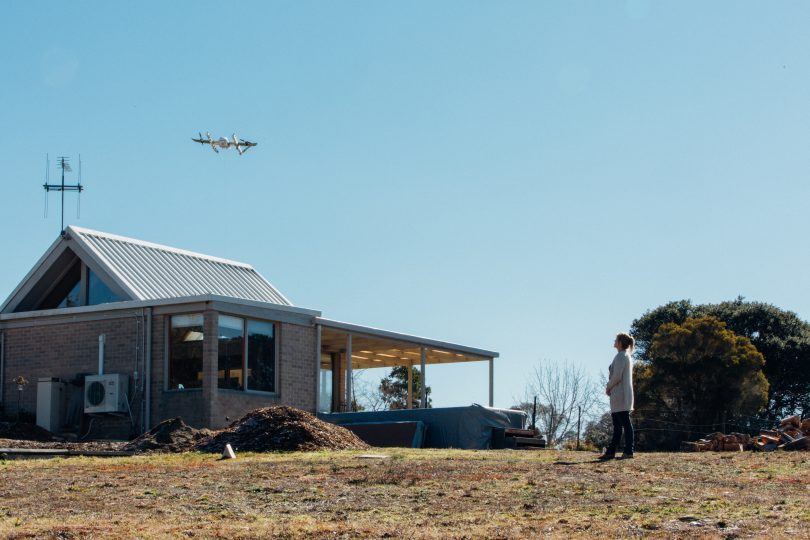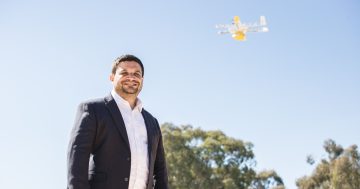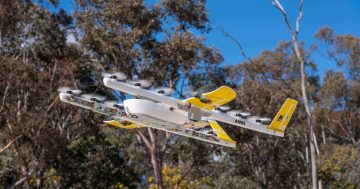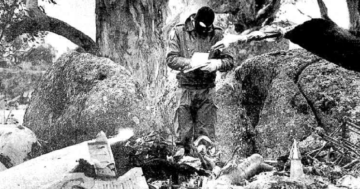
A Project Wing drone delivery. Photo: Supplied by Project Wing.
The company trialling drone delivery in Canberra rejects claims that it is getting ahead of itself by moving to set up a permanent operations base in Mitchell in preparation to offer services to the Gungahlin suburbs, as a Legislative Assembly inquiry takes shape.
Project Wing CEO James Burgess insists that the company is taking incremental steps, accepting feedback and making adjustments to its operation, particularly making its aircraft quieter, so that it can be less intrusive.
He also welcomes the inquiry. “We’re not just trying to push our solution that we think is good, we really want the feedback and want to be able to tell our story and the value that we offer and see how that fits in the ACT and with local communities,” he said.
“This technology is so new that we think it’s important to make sure that the conversation continues between communities and government and technology providers like ourselves. And we think that’s going to lead to some better outcomes.”
He said Canberra had the opportunity to help Wing shape this technology in a way that made it more valuable.
This year Wing has been trialling drone delivery in the Tuggeranong suburb of Bonython with about 30 aircrafts after trials in Googong and Royalla, stirring up a storm of complaints about noise and invasion of privacy that made its way into Federal Parliament and the Assembly, where MLAs voted for an inquiry into drone operations.
Mr Burgess said the company had learnt a lot from its Bonython trial about the suitability of operating in residential areas and had decided to limit its scope, although it would be continuing with its current testers.
“Because of the feedback we’ve received and the improvements we want to make, around noise and things like that, we’ve chosen not to continue marketing so we don’t grow before we’re able to make improvements,” he said.

Wing tester Samantha and son. Photo: Supplied.
The warehouse property selected in Mitchell would be used to house aircraft, with newer versions on the way, and meant Wing would be closer to more businesses that could benefit from its services.
“The focus for us was to find a place where we could meet our business needs but also be in an industrial site where the presence of our system is much less intrusive to surrounding communities,” he said.
“In particular our aircraft are able to take off empty from Mitchell facility, fly to a local business and pick up those packages, and then deliver them to customers.”
Wing had conducted initial outreach to businesses and residents in the north but the company would conduct lengthy engagement before starting any Gungahlin services.
That would happen through a new Mitchell-specific website to be launched soon, meeting MLAs and on the ground doorknocking of residents and businesses. It was already engaging with the Civil Aviation Safety Authority about the aviation approvals for the north side of Canberra.
Mr Burgess said Wing took privacy issues seriously and had protections in place to ensure people’s privacy is maintained. He tried to allay fears about the cameras on its aircraft, saying they were backup navigation sensors to its GPS system, with no human operators looking at a feed of video, as could be the case with other drone cameras.
He acknowledged that the technology was unfamiliar and that it had to prove itself to be accepted.
“The way to get people to accept it is to show tremendous value to the point that they would prefer to not miss it. They want to have it in their communities,” he said.
“Out technology is the fastest way to transport packages in the city. It will be the least expensive as well, but also it’s safer to transport packages by drone than automobile by removing the miles driven and the car accidents we see on the road, as well as being environmentally friendly if electrically powered and there are no carbon emissions.”
Modelling estimated that drone delivery could reduce traffic congestion in the ACT by 35 million vehicle kilometres each year, which also could mean the avoidance of up to 70 road accidents a year.
“And for the more than 13,000 disabled and 6,700 elderly people living in the ACT who may need assistance with mobility, our technology will help make Canberra a far more accessible and convenient place to live,” he said.
“We can look at all those benefits to society and we can make a compelling case that it’s a very agreeable and beneficial way to move transportation into the skies but we have to tell that story and make sure we live it and deliver that value that we’re promising.”
For those wondering how you regulate an airspace filled with drones, Mr Burgess said Wing was working on a drone traffic management system – a software application to route drones around each other and obstacles that the company was making available to third parties “because we want to see other industry players be successful in the skies as well”.
“We talk about it sometimes as Googlemaths for the skies but it’s a way for drones to get automated and ensure that they’re conflict-free, something CASA is very interested in as well as a way to enhance the Australian aviation space,” Mr Burgess said.















